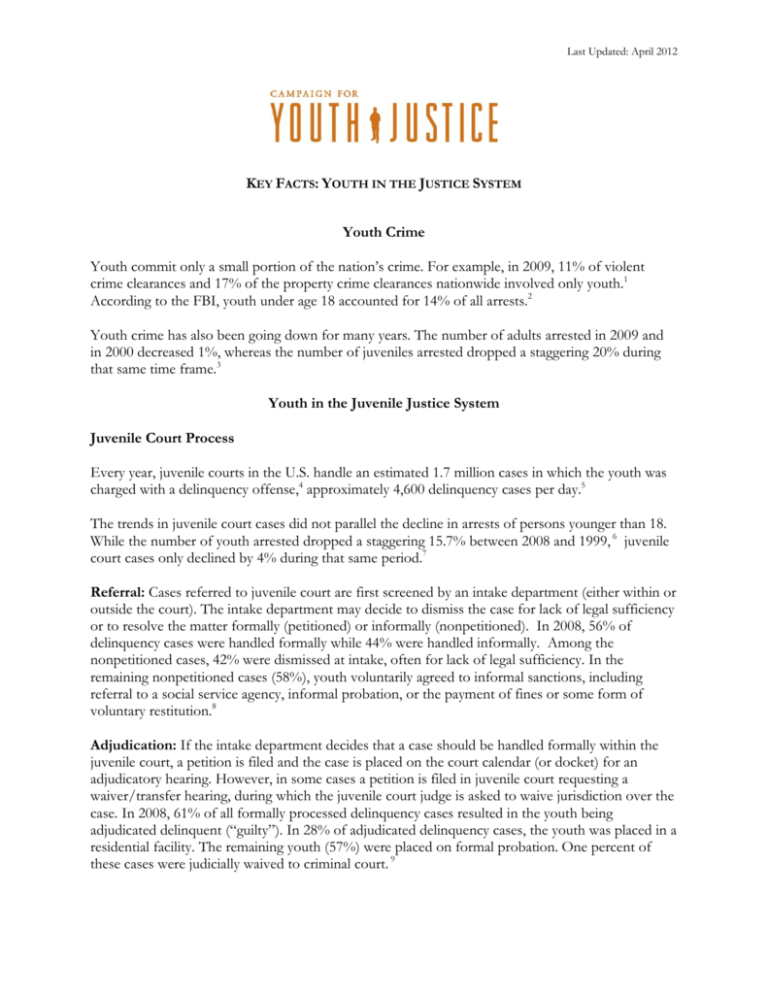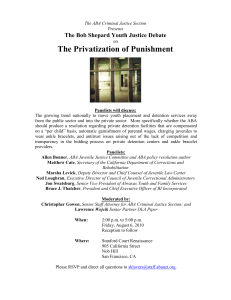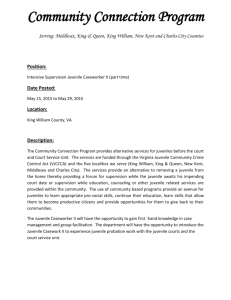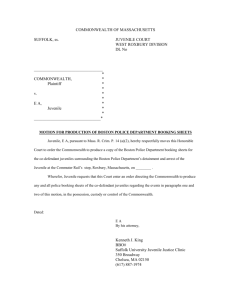key facts: youth in the justice system
advertisement

Last Updated: April 2012 KEY FACTS: YOUTH IN THE JUSTICE SYSTEM Youth Crime Youth commit only a small portion of the nation’s crime. For example, in 2009, 11% of violent crime clearances and 17% of the property crime clearances nationwide involved only youth.1 According to the FBI, youth under age 18 accounted for 14% of all arrests.2 Youth crime has also been going down for many years. The number of adults arrested in 2009 and in 2000 decreased 1%, whereas the number of juveniles arrested dropped a staggering 20% during that same time frame.3 Youth in the Juvenile Justice System Juvenile Court Process Every year, juvenile courts in the U.S. handle an estimated 1.7 million cases in which the youth was charged with a delinquency offense,4 approximately 4,600 delinquency cases per day.5 The trends in juvenile court cases did not parallel the decline in arrests of persons younger than 18. While the number of youth arrested dropped a staggering 15.7% between 2008 and 1999, 6 juvenile court cases only declined by 4% during that same period.7 Referral: Cases referred to juvenile court are first screened by an intake department (either within or outside the court). The intake department may decide to dismiss the case for lack of legal sufficiency or to resolve the matter formally (petitioned) or informally (nonpetitioned). In 2008, 56% of delinquency cases were handled formally while 44% were handled informally. Among the nonpetitioned cases, 42% were dismissed at intake, often for lack of legal sufficiency. In the remaining nonpetitioned cases (58%), youth voluntarily agreed to informal sanctions, including referral to a social service agency, informal probation, or the payment of fines or some form of voluntary restitution.8 Adjudication: If the intake department decides that a case should be handled formally within the juvenile court, a petition is filed and the case is placed on the court calendar (or docket) for an adjudicatory hearing. However, in some cases a petition is filed in juvenile court requesting a waiver/transfer hearing, during which the juvenile court judge is asked to waive jurisdiction over the case. In 2008, 61% of all formally processed delinquency cases resulted in the youth being adjudicated delinquent (“guilty”). In 28% of adjudicated delinquency cases, the youth was placed in a residential facility. The remaining youth (57%) were placed on formal probation. One percent of these cases were judicially waived to criminal court. 9 Juvenile Detention & Corrections On any given day, over 70,000 juvenile offenders are not living in their homes but are held in residential placement (e.g., juvenile detention facilities, corrections facilities, group homes or shelters).10 After arrest, many youth are detained in a detention or other residential facility to await a hearing in juvenile or adult court, depending on how they are charged. While in out-of-home placement, youth are separated from their community and their normal day-to-day life (school, jobs, family, etc.). Every day, there are over 20,000 youth who are detained in America.11 1 out of every 5 youth (21%) who is brought before the court with a delinquency case is detained.12 Detention facilities are meant to temporarily house youth who are likely to commit another crime before their trial or who are likely to skip their court date. Unfortunately, many of the youth held in the 591 detention centers across the country do not meet these criteria and should not be there.13 Most detained youth are held in locked “secure” settings such as a juvenile detention facility. Of these youth, 83% are confined by three or more locks during the day (e.g., youth are locked within buildings, within areas within buildings, and within external fences or walls).14 Two-thirds of youth in detention are held for nonviolent charges. These youth are charged with property offenses, drug offenses, public order offenses, technical probation violations, or status offenses (crimes that wouldn’t be crimes if they were adults, like running away or breaking curfew).15 One quarter (25%) of detention centers are at or over their capacity, which impairs the ability of the facility to properly care for the youth.16 A one-day snapshot of juvenile offenders in detention found that roughly 2% were status offenders, however this number does not account for the number of youth who are held in detention facilities after violating a valid court order.17 After adjudication, many youth are sentenced to juvenile correctional facilities or state training schools. On any given day, approximately 50,000 youth are held in an out-of-home placement. Roughly one-third of these youth (17,000) are committed to an incarceration facility such as a state training school.18 Confined youth are at great risk of sexual assault. More than 1 in 10 youth (12%) in state juvenile facilities and large non-state facilities reported experiencing one or more incidents of sexual victimization by another youth or facility staff in the past 12 months or since admission, if less than 12 months.19 There are less severe alternatives to incarcerating youth, and they work. Community-based programs, including diversion programs, drug treatment, evening reporting centers, treatment clinics and family programs, have been shown to be less costly than detention or incarceration and to help youth stay out of trouble and to not re-offend.20 2 Youth in the Adult Criminal Justice System An estimated 250,000 youth are tried, sentenced, or incarcerated as adults every year across the United States.21 Most of the youth prosecuted in adult court are charged with non-violent offenses.22 Research shows that young people who are kept in the juvenile justice system are less likely to reoffend than young people who are transferred into the adult system. According to the Centers for Disease Control and Prevention, youth who are transferred from the juvenile court system to the adult criminal system are approximately 34% more likely than youth retained in the juvenile court system to be re-arrested for violent or other crime. 23 Youth sentenced as adults receive an adult criminal record, are often denied employment and educational opportunities, and can be barred from receiving student financial aid.24 Housing Youth in Adult Jails and Prisons On any given night in America, 10,000 children are held in adult jails and prisons.25 State laws vary widely as to whether youth can be housed in adult facilities. Although the federal Juvenile Justice and Delinquency Prevention Act (JJDPA) requires that youth in the juvenile justice system be removed from adult jails or be sight-and-sound separated from other adults, these protections do not apply to youth prosecuted in the adult criminal justice system.26 Most youth are denied educational and rehabilitative services that are necessary for their stage in development when in adult facilities. A survey of adult facilities found that 40% of jails provided no educational services at all, only 11% provided special education services, and a mere 7% provided vocational training.27 This lack of education increases the difficulty that youth will have once they return to their communities. Youth are in extreme danger when held in adult facilities. Jailers and Corrections officials are faced with a “no win” situation when youth are placed in adult facilities: they simply can't keep youth safe and segregating youth in isolation/solitary confinement creates a different, but equally harmful result. Many children are often placed in isolation which can produce harmful consequences, including death. Youth are frequently locked down 23 hours a day in small cells with no natural light. These conditions can cause anxiety, paranoia, and exacerbate existing mental disorders and put youth at risk of suicide. In fact, youth housed in adult jails are 36 times more likely to commit suicide than are youth housed in juvenile detention facilities.28 Youth who are held in adult facilities are at the greatest risk of sexual victimization. According to research by the Bureau of Justice Statistics, youth under the age of 18 represented 21 percent of all substantiated victims of inmate-on-inmate sexual violence in jails in 2005, and 13 percent in 2006 – surprisingly high since only one percent of jail inmates are juveniles.29 The National Prison Rape 3 Elimination Commission found that “more than any other group of incarcerated persons, youth incarcerated with adults are probably at the highest risk for sexual abuse.” 30 Adult Jails: On any given day, nearly 7,500 young people are locked up in adult jails.31 Currently, 39 states permit or require that youth charged as adults be held before they are tried in an adult jail. In some states, if they are convicted, they may be required to serve their entire sentence in an adult jail.32 Many youth who are held in adult jails have not even been convicted. Research shows that many never will. As many as one-half of these youth will be sent back to the juvenile justice system or will not be convicted. Yet, most of these youth will have spent at least one month in an adult jail, and one in five of these youth will have spent over six months in an adult jail.33 Adult Prisons: On any given day, approximately 2,700 young people are locked up in adult prisons.34 The majority of youth held in adult prisons are not the most serious offenders and are likely to be released in early adulthood. Approximately 80 percent of youth convicted as adults will be released from prison before their 21st birthday, and 95 percent will be released before their 25th birthday.35 At the other extreme, we know that some young people incarcerated in adult prisons will expect to spend the majority of their lifetimes behind bars. Human Rights Watch reported in 2009 that an estimated 2,600 people were serving life without parole for crimes they committed while under age 18.36 Racial and Ethnic Disparities Youth of color are over-represented at all stages in the juvenile justice system, according to the National Council on Crime and Delinquency in their January 2007 report, “And Justice for Some.” African-American youth overwhelmingly receive harsher treatment than white youth in the juvenile justice system at most stages of case processing. African-American youth make up 30% of those arrested while they only represent 17% of the overall youth population. At the other extreme end of the system, African-American youth are 62% of the youth prosecuted in the adult criminal system and are nine times more likely than white youth to receive an adult prison sentence.37 Compared to white youth, Latino youth are 4% more likely to be petitioned, 16% more likely to be adjudicated delinquent, 28% more likely to be detained, and 41% more likely to receive an out-ofhome placement. The most severe disparities occur for Latino youth tried in the adult system. Latino children are 43% more likely than white youth to be waived to the adult system and 40% more likely to be admitted to adult prison.38 Native youth are more likely to receive to the two most severe punishments in juvenile justice systems: out-of-home placement (i.e., incarceration in a state correctional facility) and waiver to the adult system. Compared to white youth, Native youth are 1.5 times more likely to receive out-ofhome placement and are 1.5 times more likely to be waived to the adult criminal system. Nationwide, the average rate of new commitments to adult state prison for Native youth is 1.84 times that of white youth.39 4 Family Involvement The ability of family members to meaningfully participate in their children’s lives makes a dramatic difference on youth outcomes. The overwhelming majority (94%) of youth want to maintain contact with their family.40 The frequency of family contact varies significantly by type of program that youth are involved in. Many youth who are incarcerated are unable to have regular contact with family. Thirty-nine percent of corrections and camp youth have family contact less than once a week. 41 One third of youth who have no in-person visits indicate that this is due to time constraints or distance. In fact, the majority of all youth in custody (59%) say that it would take their families 1 hour or longer to travel to visit them. For more than one-fourth of youth (28%), their families would have to travel 3 hours or longer to see them.42 Cost Effective Alternatives Incarcerating young people in juvenile detention facilities costs between $32,000 and $65,000 per year,43 and operating just one bed over a twenty-year period can cost between $1.25 million and $1.5 million.44 Alternatives to incarcerating youth not only reduce crime, but save money. Research has shown that every dollar spent on evidence-based programs [e.g., Multidimensional Treatment Foster Care (MTFC), Multisystemic Therapy (MST), and Functional Family Therapy (FFT)] can yield up to $13 in cost savings.45 Early interventions that prevent high-risk youth from engaging in repeat criminal offenses can save the public nearly $5.7 million in costs over a lifetime.46 5 References Federal Bureau of Investigation. Crime in the United States 2009. Washington, D.C. Retrieved July 12, 2011 from http://www.fbi.gov/ucr/cius2009/data/table_28.html. 2 Federal Bureau of Investigation. Crime in the United States 2009. Washington, D.C. Retrieved July 12, 2011 from http://www.fbi.gov/ucr/cius2009/data/table_32.html.. 3Federal Bureau of Investigation. Crime in the United States 2009. Washington, D.C., Retrieved July 12, 2011from http://www.fbi.gov/ucr/cius2009/data/table_32.html. 4 OJJDP Statistical Briefing Book. Online. Available: http://www.ojjdp.gov/ojstatbb/court/qa06201.asp?qaDate=2008. Released on May 06, 2011 5 Puzzanchera, C., Adams, B., and Sickmund, M. (2010). Juvenile Court Statistics 2006-2007. Pittsburgh, PA: National Center for Juvenile Justice. 6Federal Bureau of Investigation. Crime in the United States 2008. Washington, D.C., Retrieved October 26, 2009 from http://www.fbi.gov/ucr/cius2008/data/table_32.html. 7 OJJDP Statistical Briefing Book. Online. Available: http://www.ojjdp.gov/ojstatbb/court/qa06201.asp?qaDate=2008. Released on May 06, 2011. 8 OJJDP Statistical Briefing Book. Online. Available: http://www.ojjdp.gov/ojstatbb/court/qa06201.asp?qaDate=2008. Released on May 06, 2011. 9 OJJDP Statistical Briefing Book. Online. Available: http://www.ojjdp.gov/ojstatbb/court/qa06201.asp?qaDate=2008. Released on May 06, 2011. 10 OJJDP Statistical Briefing Book. Online. Available: http://www.ojjdp.gov/ojstatbb/corrections/qa08201.asp?qaDate=2010. Released on December 09, 2011. 11 Sickmund, M., Sladky, T.J., Kang, W., & Puzzanchera, C. (2011). "Easy Access to the Census of Juveniles in Residential Placement." Available: http://ojjdp.ncjrs.gov/ojstatbb/ezacjrp/ 12 OJJDP Statistical Briefing Book. Online. Available: http://www.ojjdp.gov/ojstatbb/court/qa06301.asp?qaDate=2008. Released on May 06, 2011. 13 Holman, B. and Ziedenberg, J. (November 2006). The Dangers of Detention: The Impact of Incarcerating Youth in Detention and Other Secure Facilities. Washington, DC. Justice Policy Institute. P. 2. 14 Sedlack, A., and McPherson, K. (May 2010). Conditions of Confinement: Findings from the Survey of Youth in Residential Placement. Washington, DC: U.S. Department of Justice, Office of Justice Programs, Office of Juvenile Justice and Delinquency Prevention. 15 Sickmund, M., Sladky, T.J., Kang, W., & Puzzanchera, C. (2011). "Easy Access to the Census of Juveniles in Residential Placement." Available: http://ojjdp.ncjrs.gov/ojstatbb/ezacjrp/ 16Livsey, S, Sickmund, M., & Sladky, A. (2009). Juvenile Residential Facility Census, 2004: Selected Findings. Washington, DC: U.S. Department of Justice, Office of Justice Programs, Office of Juvenile Justice and Delinquency Prevention. 17 Sickmund, M., Sladky, T.J., Kang, W., & Puzzanchera, C. (2011). "Easy Access to the Census of Juveniles in Residential Placement." Available: http://ojjdp.ncjrs.gov/ojstatbb/ezacjrp/ 18 Sickmund, M., Sladky, T.J., Kang, W., & Puzzanchera, C. (2011). "Easy Access to the Census of Juveniles in Residential Placement." Available: http://ojjdp.ncjrs.gov/ojstatbb/ezacjrp/ 19 Beck, A., Harrison, P., and Guerino, P. (January 2010). Sexual Victimization in Juvenile Facilities Reported by Youth, 200809. Washington, DC: U.S. Department of Justice, Office of Justice Programs, Bureau of Justice Statistics. 20 Juvenile Detention Alternatives Initiative. Detention Reform: An Effective Public Safety Strategy. Online: http://www.jdaihelpdesk.org/Docs/Documents/z%20044-07_JDAI_factsheet2_r13bl.pdf Retrieved October 9, 2008. 21 Arya, Neelum. (2011). State Trends: Legislative Victories from 2005 to 2010 Removing Youth from the Adult Criminal Justice System. Washington, DC: Campaign for Youth Justice. 22 Arya, Neelum. (2011). State Trends: Legislative Victories from 2005 to 2010 Removing Youth from the Adult Criminal Justice System. Washington, DC: Campaign for Youth Justice. 23 Centers for Disease Control and Prevention. (2007) Effects on Violence of Laws and Policies Facilitating the Transfer of Youth from the Juvenile to the Adult Justice System: A Report on Recommendations of the Task Force on Community Preventive Services. MMWR 2007; 56 (No. RR-9). Available online at http://www.cdc.gov/mmwr/pdf/rr/rr5609.pdf. 24 Arya, Neelum. (2011). State Trends: Legislative Victories from 2005 to 2010 Removing Youth from the Adult Criminal Justice System. Washington, DC: Campaign for Youth Justice. 25 Minton, Todd D. (June 2010). Jail inmates at midyear 2009. Washington, DC: U.S. Department of Justice, Bureau of Justice Statistics. West, Heather C. (June 2010). Prison inmates at midyear 2009. Washington, DC: U.S. Department of Justice, Bureau of Justice Statistics. 26 Jailing Juveniles (2007, November). Washington, DC: Campaign for Youth Justice. 1 6 Harlow, C.W. (2003, January). Education and Correctional Populations. Washington, D.C.: U.S. Department of Justice, Office of Justice Programs, Bureau of Justice Statistics. 28 Jailing Juveniles (2007, November). Washington, DC: Campaign for Youth Justice. 29 Beck, A.J., Harrison, P.M., Adams, D.B. (2007, August). Sexual Violence Reported by Correctional Authorities, 2006. Washington, DC: U.S. Department of Justice, Office of Justice Programs, Bureau of Justice Statistics. Beck, A. J., Harrison, P.M., Adams, D.B. (2007, August). Sexual Violence Reported by Correctional Authorities, 2005. Washington, DC: U.S. Department of Justice, Office of Justice Programs, Bureau of Justice Statistics. 30National Prison Rape Elimination Commission, Report 18 (June 2009), available at http://www.ncjrs.gov/pdffiles1/226680.pdf. 31 Jailing Juveniles (2007, November). Washington, DC: Campaign for Youth Justice. 32 Jailing Juveniles (2007, November). Washington, DC: Campaign for Youth Justice. 33 Jailing Juveniles (2007, November). Washington, DC: Campaign for Youth Justice. 34 West, Heather C. (June 2010). Prison inmates at midyear 2009. Washington, DC: U.S. Department of Justice, Bureau of Justice Statistics. 35 Richard E. Redding, Juvenile transfer laws: An effective deterrent to delinquency? (Washington, D.C.: U.S. Department of Justice, Office of Justice Programs, Office of Juvenile Justice and Delinquency Prevention) (Aug. 2008). 36 Human Rights Watch. State Distribution of Estimated 2,574 Juvenile Offenders Serving Life Without Parole. (October 2009). New York. NY. Retrieved on October 26, 2009 from http://www.hrw.org/en/news/2009/10/02/state-distribution-juvenile-offenders-serving-juvenile-life-without-parole. 37 Arya, N. & Augarten, I. Critical Condition: African-American Youth in the Justice System. (2008, September) Washington, DC: Campaign for Youth Justice. 38 Arya, N., Villarruel, F., Villanueva, C., & Augarten, I. America’s Invisible Children: Latino Youth and the Failure of Justice. (2009, May) Washington, DC: Campaign for Youth Justice. 39 Arya, N., & Rolnick, A. A Tangled Web of Justice: American Indian and Alaska Native Youth in Federal, State, and Tribal Justice Systems. (2008, May) Washington, DC: Campaign for Youth Justice. 40 Sedlack, A., and McPherson, K. (May 2010). Conditions of Confinement: Findings from the Survey of Youth in Residential Placement. Washington, DC: U.S. Department of Justice, Office of Justice Programs, Office of Juvenile Justice and Delinquency Prevention. 41 Sedlack, A., and McPherson, K. (May 2010). Conditions of Confinement: Findings from the Survey of Youth in Residential Placement. Washington, DC: U.S. Department of Justice, Office of Justice Programs, Office of Juvenile Justice and Delinquency Prevention. 42 Sedlack, A., and McPherson, K. (May 2010). Conditions of Confinement: Findings from the Survey of Youth in Residential Placement. Washington, DC: U.S. Department of Justice, Office of Justice Programs, Office of Juvenile Justice and Delinquency Prevention. 43 Juvenile Detention Alternatives Initiative, (2007). Detention Reform Brief 1: Detention Reform: A Cost-Saving Approach, Annie E. Casey Foundation, available at http://www.aecf.org/upload/PublicationFiles/jdai_facts1.pdf. 44 National Association of Counties, (February 2007). Juvenile Detention Reform: Guide for County Officials, available at http://www.nicic.org/Library/022376. 45 Juvenile Detention Alternatives Initiative, (2007). Detention Reform Brief 1: Detention Reform: A Cost-Saving Approach, Annie E. Casey Foundation, available at http://www.aecf.org/upload/PublicationFiles/jdai_facts1.pdf. 46 Cohen, Mark A. and Piquero, Alex R., New Evidence on the Monetary Value of Saving a High Risk Youth, Vanderbilt Law and Economics Research Paper No. 08-07, available at SSRN: http://ssrn.com/abstract=1077214. (December 2007). 27 7





